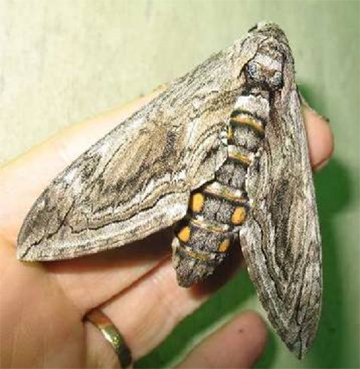Moth creates conundrum for gardeners
“What is that giant thing on my tomato? And, “What happened to that tomato plant! All its leaves have been stripped away!” Every year, these questions arrive from horrified gardeners who call the Master Gardener help line.
People who enjoy gardening have much in common with other people who appreciate the natural world. Take, for instance, the people who have completed the training required for the Nevada Naturalist program.
Cooperative Extension developed this 60-hour course to create a cadre of naturalist volunteers who assist public partners such as the Bureau of Land Management and the National Park Service in their efforts to improve or restore the environment in the southern Mojave.
Several of these trained naturalists come from the ranks of the Southern Nevada Extension Master Gardeners. These community members have completed the required 80 hours of training and then volunteer in one or more projects where they teach the public how to garden sustainably in this challenging area.
Fruit trees and most vegetables did not evolve in the Mojave, and require a relatively high amount of resources to survive. Almost by definition, gardeners modify the environment to grow plants that otherwise wouldn’t be able to survive in this region.
Although gardeners must alter their own growing environment, members of both the Nevada Naturalists and the Master Gardeners have a great sense of the ecological value of the plants, birds and other animals that make our area unique.
Not every member of the natural world is a welcome addition to every garden, however. Consider the insect known as the hawk moth or the sphinx moth (Manduca species).
The adult is remarkable for its dramatic markings, and more noticeably, its astonishing size. Many people are amazed that something so big can be a flying insect.
Long ago, it was termed “hummingbird moth,” but that term now describes a different species of insect, called a clearwing moth, which does not generally inhabit this part of the United States. These hummingbird moths appear during the daylight hours, unlike the sphinx, which are nighttime visitors.
The sphinx moth is ubiquitous, not only in Southern Nevada, but across the country. It is an important pollinator. This is particularly significant for white flowers that are open at night.
Bees, which fly during the day, are major pollinators for many crops in the U.S. They are dying off in huge numbers. Likewise, certain butterflies are important for pollinating flowers, but they, too, are disappearing. With the demise of other pollinators, it is a good idea for all of us to be concerned with maintaining the creatures who spread pollen from flower to flower.
We frequently forget, unfortunately, that butterflies and moths have younger stages that might not look remotely like the striking adults they will become. Caterpillars may or may not have coloration that is at all similar to the adults. Monarch larvae (caterpillars) have the same general colors as the mature butterfly, while the larvae of sphinx moths are a vivid green.
The young of sphinx moths can overwinter in the soil wherever winters are not harsh enough to kill them. Once spring arrives, these very hungry caterpillars begin to emerge.
These larvae are the dreaded tobacco hornworm (Manduca sexta), or tomato hornworm (M. quinquemaculata). They are cousins, identifiable by the spine sticking up at their tails. The more common tobacco hornworm has seven diagonal stripes, while its tomato relative has eight V-shaped chevrons on its side.
Tobacco and tomatoes are relatives, along with peppers, eggplants and petunias, among others. Both the tobacco and tomato hornworms will defoliate any member of the tomato family in short order. The bright green is good camouflage as it eats the leaves.
Once the moths’ hiding places have been discovered, the gardener must make a decision. Are the moths, which are interesting and attractive pollinators, more desirable than the plants, which their offspring are devouring?
Impressive as I find these moths, I prefer the tomatoes and peppers that I spend so much time and effort to get productive.
Prevention is the best treatment — keeping the garden weed-free removes hiding places.
To lessen the damage hornworms cause, try applying Bacillus thuringiensis powder to the soil and plants. Commercially available as Dipel and Thuricide, this organic bacterial product kills the caterpillars of many moths and butterflies. There are biological control methods that are effective and organic. These are available online.
Angela O’Callaghan is the Social Horticulture Specialist for University of Nevada Cooperative Extension. Contact ocallaghana@unce.unr.edu or 702-257-5581.


















